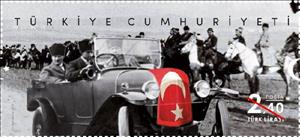Stamp: Mustafa Kemal's Arrival in Ankara, 1919 (Turkey 2019)
Mustafa Kemal's Arrival in Ankara, 1919 (Turkey 2019)
27 December (Turkey ) within release Centenary of Mustafa Kemal's Arrival in Ankara (2019) goes into circulation Stamp Mustafa Kemal's Arrival in Ankara, 1919 face value 2.40 Turkish lira
| Stamp Mustafa Kemal's Arrival in Ankara, 1919 in catalogues | |
|---|---|
| Colnect codes: | Col: TR 2019-33Ba |
Stamp is square format.
stamp from souvenir sheetAlso in the issue Centenary of Mustafa Kemal's Arrival in Ankara (2019):
- Souvenir Sheet - Mustafa Kemal (Ataturk) face value 5.50;
- Stamp - Committee of Representation in Ankara, 1919 face value 2.40;
- Stamp - Committee of Representation in Ankara, 1919 face value 2.40;
- Stamp - Mustafa Kemal's Arrival in Ankara, 1919 face value 2.40;
- Souvenir Sheet - Centenary of Mustafa Kemal's Arrival in Ankara face value 9.60;
- Stamp - Mustafa Kemal (Ataturk) face value 5.50;
- Stamp - Mustafa Kemal, 1919 face value 2.40;
- Stamp - Agricultural School, Nationalist Headquarters in 1919 face value 2.40;
- Souvenir Sheet - Mustafa Kemal's Arrival in Ankara, 1919 face value 2.40;
Stamp Mustafa Kemal's Arrival in Ankara, 1919 it reflects the thematic directions:
A car is a wheeled, self-powered motor vehicle used for transportation and a product of the automotive industry. Most definitions of the term specify that cars are designed to run primarily on roads, to have seating for one to eight people, to typically have four wheels with tyres, and to be constructed principally for the transport of people rather than goods. The year 1886 is regarded as the birth year of the modern car. In that year, German inventor Karl Benz built the Benz Patent-Motorwagen. Cars did not become widely available until the early 20th century. One of the first cars that was accessible to the masses was the 1908 Model T, an American car manufactured by the Ford Motor Company. Cars were rapidly adopted in the United States of America, where they replaced animal-drawn carriages and carts, but took much longer to be accepted in Western Europe and other parts of the world.
World War I or the First World War (28 July 1914 – 11 November 1918), also known as the Great War, was a global conflict between two coalitions: the Allies (or Entente) and the Central Powers. Main areas of conflict included Europe and the Middle East, as well as parts of Africa and the Asia-Pacific. There were important developments in weaponry including tanks, aircraft, artillery, machine guns, and chemical weapons. One of the deadliest conflicts in history, it resulted in an estimated 30 million military casualties, plus another 8 million civilian deaths from war-related causes and genocide. The movement of large numbers of people was a major factor in the deadly Spanish flu pandemic.
A flag is a piece of fabric (most often rectangular or quadrilateral) with a distinctive design that is used as a symbol, as a signaling device, or as decoration. The term flag is also used to refer to the graphic design employed, and flags have since evolved into a general tool for rudimentary signalling and identification, especially in environments where communication is similarly challenging (such as the maritime environment where semaphore is used). National flags are patriotic symbols with varied wide-ranging interpretations, often including strong military associations due to their original and ongoing military uses. Flags are also used in messaging, advertising, or for other decorative purposes. The study of flags is known as vexillology, from the Latin word vexillum, meaning flag or banner.


